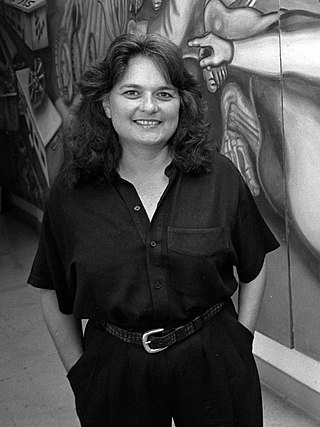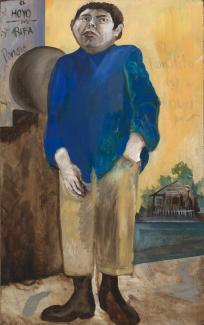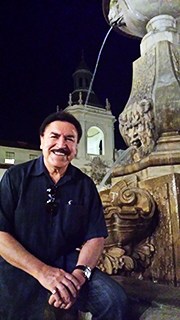
City Terrace is an unincorporated area of East Los Angeles, in Los Angeles County, California, east of Downtown Los Angeles. It contains City Terrace Elementary School, Robert F. Kennedy Elementary School, Esteban Torres High School, Harrison Elementary School, William R. Anton Elementary School, Hammel Street Elementary School, Anthony Quinn Library, City Terrace Library, and City Terrace Park. It is part of the Census-designated place of East Los Angeles.

Estrada Courts is a low-income housing project in the Boyle Heights area of Los Angeles, California. It is located between E. Olympic Blvd. on the south and E. 8th St. on the north, and S. Lorena St. on the east and S. Grande Vista Ave. on the west.
The Royal Chicano Air Force (RCAF) is a Sacramento, California-based art collective, founded in 1970 by Ricardo Favela, José Montoya and Esteban Villa. It was one of the "most important collective artist groups" in the Chicano art movement in California during the 1970s and the 1980s and continues to be influential into the 21st century.

Gronk, born Glugio Nicandro, is a Chicano painter, printmaker, and performance artist. His work is collected by museums around the country including the Smithsonian American Art Museum.
Los Four was a Chicano artist collective active based in Los Angeles, California. The group was instrumental in bringing the Chicano art movement to the attention of the mainstream art world.

The Centro Cultural de la Raza is a non-profit organization with the specific mission to create, preserve, promote and educate about Chicano, Mexicano, Native American and Latino art and culture. It is located in Balboa Park in San Diego, California.The cultural center supports and encourages the creative expression “of the indigenous cultures of the Americas.” It is currently a member of the American Alliance of Museums.

Judith Francisca Baca is an American artist, activist, and professor of Chicano studies, world arts, and cultures based at the University of California, Los Angeles. She is the co-founder and artistic director of the Social and Public Art Resource Center (SPARC) in Venice, California. Baca is the director of the mural project that created the Great Wall of Los Angeles, which is the largest communal mural project in the world.

The Social and Public Art Resource Center is a non-profit community arts center based in Venice, California. SPARC hosts exhibitions, sponsors workshops and murals, and lobbies for the preservation of Los Angeles area murals and other works of public art. SPARC hosts several community programs and artist spaces, including the UCLA@SPARC Digital Mural Lab, a "comprehensive" archive, printmaking studios, an art gallery and a University of California, Los Angeles (UCLA) graduate program. According to its mission statement, "SPARC espouses public art as an organizing tool for addressing contemporary issues, fostering cross-cultural understanding and promoting civic dialogue."
Nova Color Artists Acrylic Paint was first manufactured in Culver City, California in 1965 shortly after the commercial introduction of acrylic polymer resin for paint production. Mexican immigrant Carlos Amparan developed a line of brilliantly colored fine art acrylic paint after experimenting with this relatively new water-borne emulsion. He and his brother Raoul began small-scale production of Nova Color and sold it at a low price to local artists.

The Chicano Art Movement represents groundbreaking movements by Mexican-American artists to establish a unique artistic identity in the United States. Much of the art and the artists creating Chicano Art were heavily influenced by Chicano Movement which began in the 1960s.
Willie Herrón III is an American Chicano muralist, performance artist and commercial artist.
Asco was an East Los Angeles based Chicano artist collective, active from 1972 to 1987. Asco adopted its name as a collective in 1973, making a direct reference to the word's significance in Spanish ("asco"), which is disgust or repulsion. Asco's work throughout 1970s and 1980s responded specifically to socioeconomic and political problems surrounding the Chicano community in the United States, as well the Vietnam War. Harry Gamboa Jr., Glugio "Gronk" Nicandro, Willie Herrón and Patssi Valdez form the core members of the group.

Roberto Chavez is an American artist. known for his personally symbolic portraits, public murals and "funny-grotesque" paintings that reflect the multicultural landscape of Los Angeles. He was recently included in the Getty Center's Pacific Standard Time: Art in L.A., 1945-1980 and the Smithsonian’s Our America: The Latino Presence in American Art exhibits.
Yreina Cervantez is an American artist and Chicana activist who is known for her multimedia painting, murals, and printmaking. She has exhibited nationally and internationally, and her work is in the permanent collections of the Smithsonian American Art Museum, The Mexican Museum, the Los Angeles County Museum, and the Los Angeles Museum of Contemporary Art.
Chicano Art: Resistance and Affirmation was a traveling exhibit of Chicano/a artists which toured the United States from 1990 through 1993. CARA visited ten major cities and featured over 128 individual works by about 180 different Chicano/a artists. The show was also intended to visit Madrid and Mexico City. CARA was the first time a Chicano exhibit received major attention from the press and it was the first exhibit that collaborated between Chicanos and major museums in the U.S. The show was considered a "notable event in the development of Chicano art." Another unique feature of CARA was the "extensive planning" that attempted to be as inclusive as possible and which took place more than five years prior to the opening at Wight Art Gallery.

Jose Luis Gonzalez is a restorer, designer, painter, muralist, sculptor, ceramist, appraiser, importer, and arts administrator.

Beginning with the Chicano Movement of the 1960s, Chicanas used art to express political and social resistance. Through different art mediums both past and contemporary, Chicana artists have continued to explore and interrogate traditional Mexican-American values and embody feminist themes through different mediums including murals, painting, photography, and more. The momentum created from the Chicano Movement spurred a Chicano Renaissance among Chicanas and Chicanos. Political art was created by poets, writers, playwrights, and artists and used to defend against their oppression and societal marginalization. During the 1970s, Chicana feminist artists differed from their Anglo-feminist counterparts in the way they collaborated. Chicana feminist artists often utilized artistic collaborations and collectives that included men, while Anglo-feminist artists generally utilized women-only participants.
Margaret Garcia is a Chicana muralist, educator, and arts-advocate based in Los Angeles.
Patricia "Pat" Gomez is a Chicana visual artist based in Los Angeles best known for incorporating text within her art. She is currently the Civic Art Project Manager at Los Angeles County Department of Arts and Culture.

Greater Los Angeles, California, is home to thousands of murals, earning it the nickname "the mural capital of the world" or "the mural capital of America." The city's mural culture began and proliferated throughout the 20th century. Murals in Los Angeles often reflect the social and political movements of their time and highlight cultural symbols representative of Southern California. In particular, murals in Los Angeles have been influenced by the Chicano art movement and the culture of Los Angeles. Murals are considered a distinctive form of public art in Los Angeles, often associated with street art, billboards, and contemporary graffiti.










